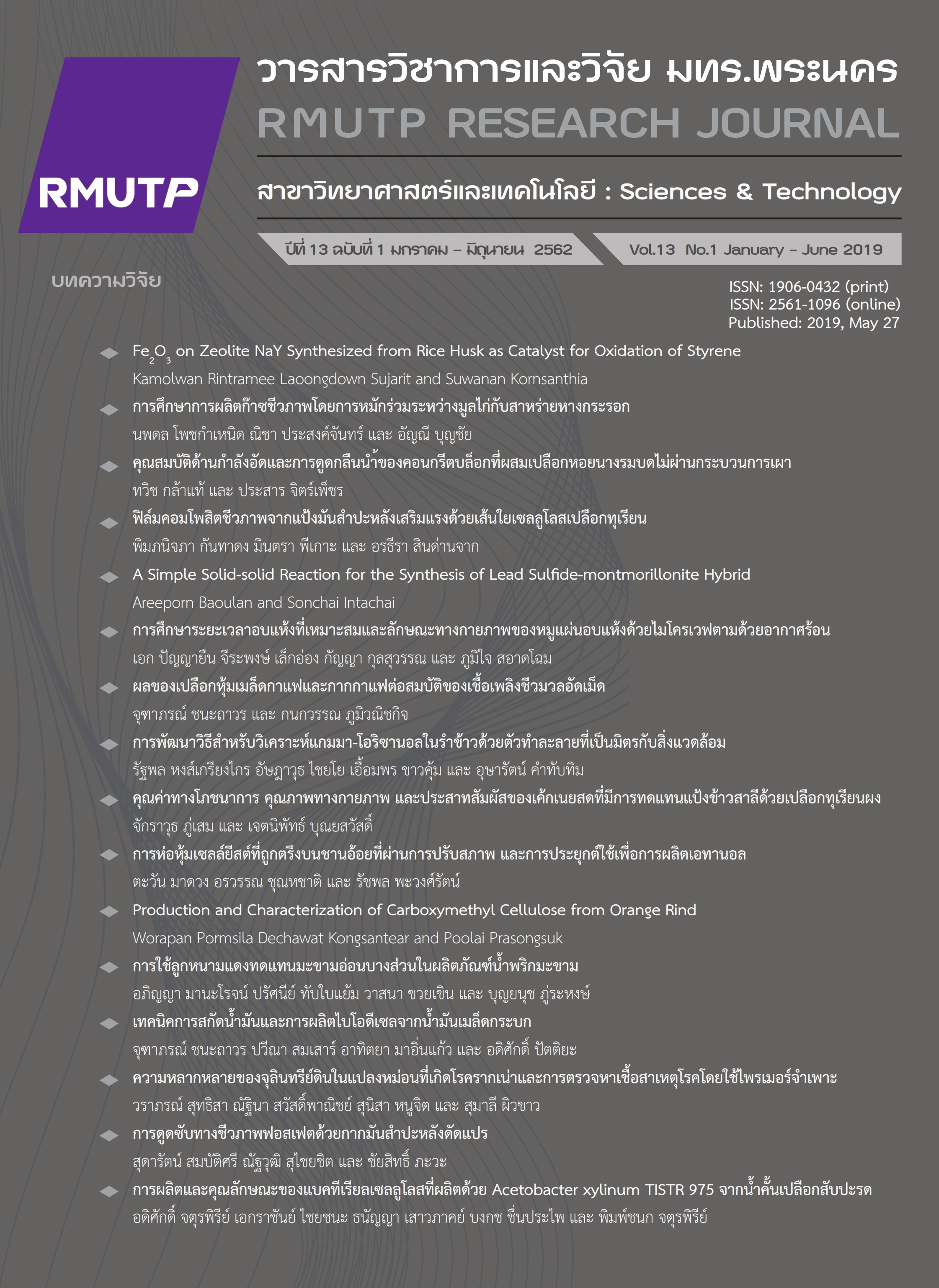Effect of Coffee Silverskin and Spent Coffee Ground on properties of Biomass pellet fuel
Main Article Content
Abstract
The objective is to produce the biomass pellet fuel from coffee silverskin and spent of coffee grounds. To study the percentage of cassava powder as binder was mixed at 5, 10, 15 and 20% by weight and the best condition was chosen. Then, to study the ratio of coffee silverskin and spent of coffee grounds was 5 ratios (100 : 0, 75 : 25, 50 : 50, 25 : 75 and 0 : 100) on propertied of biomass pellet fuel. Characteristics and properties of raw materials and biomass pellet fuel were analyzed. The results found that the highest property of the biomass pellet fuel was 20% of cassava powder as binder. The biomass pellet from spent coffee grounds as main component was higher quality than coffee silverskin. The biomass pellet from spent coffee grounds was the maximum fuel property. The bulk density was 0.9699 ± 0.0045 g/ cubic cm, shatter index was 92.6510 ± 0.2102%, heating value was 17.2772 ± 0.0319 MJ/kg and heat utilization efficiency was 16.59 ± 0.02%. The results from the part of coffee silverskin and spent of coffee grounds ratio showed that the best ratio from 2 raw materials was 25 : 75 that gave the highest quality. The heating value was 17.1544 ± 0.017 MJ/kg and heat utilization efficiency was 16.48 ± 0.01%. In addition, the study also discovered that the biomass pellet had moisture contents in the levels acceptable under biomass standards. Thus, in summary, the coffee silverskin and spent coffee grounds had physical property and fuel property according to the standardization to be made into biomass pellet fuel. It considered to be one of alternative fuels in country permanently.
Article Details
References
[2] A. Delligiannis, A. Papazafeiropoulou, G. Anastopoulos and F. Zanikos, “Waste coffee ground as an energy feedstock,” in Proceeding of the 3rd International Cempee and Secotox Conference, 2011, pp. 978-960.
[3] M. Haile, “Integrated volarization of spent coffee grounds to bio fuels,” Biofuel Research Journal, vol. 2, pp. 65-69, May. 2014.
[4] N. Caetano, S. Caetano and T.M. Mata, “Volarization of coffee grounds for biodiesel production,” Chemical Engineering Transactions, vol. 26, pp. 267-272, 2012.
[5] M. Misra, N. Kondamudi, S.K. Mohapatra and S.E. John, “High quality biodiesel from spent coffee grounds,” Clean Technology, vol. 2, pp. 39-42, 2008.
[6] F. Battista, D. Fino and G. Mancini, “Optimization of biogas production from coffee production waste,” Bioresource Technology, vol. 200, pp. 884-890, Jan. 2016.
[7] J. Kim, H. Kim, G. Baek and C. Lee, “Anaerobic co-digestion of spent coffee grounds with different waste feedstocks for biogas production,” Waste Management, vol. 60, pp. 322-328, Feb. 2017.
[8] V. Soest, P.J. and R.H. Wine, “Determination of lignin and cellulose in acid-detergent fiber with permanganate,” Journal of the Association of Official Analytical Chemists, vol. 51 pp. 780-785, 1968.
[9] V. Soest, P.J., Robertson J.B. and B.A. Lewis, “Methods for dietary fiber, neutral detergent fiber, and nonstarch polysaccharides in relation to animal nutrition.” Journal of Dairy Science, vol. 74, pp. 3583-3593, 1991.
[10] M.V., Gil, P. Oulego, C. Pevida, J.J. Pis, and F. Rubiera, “Mechanical durability and combustion characteristics of pellets from biomass blends,” Biomass Technology, vol. 101, pp. 8859-8867, 2010.
[11] N. Tanpaiboonkul and T. Budnumpetch, “Molding and binding method on properties of fuel from water hyacinth,” Science and Technology Silpakorn University Bangkok, pp. 2408-1248, 2016.
[12] S. Warajanont and N. Soponpongpipat, “Effect of particle size and moisture content on cassava root pellet fuel’s qualities follow the acceptance of pellet fuel standard,” International Journal of Renewable and Sustainable Energy, vol. 2, pp. 74-79, 2013.
[13] H. Yumak, T. Ucar and N. Seyidbekiroglu, “Briquetting soda weed (Salsolatragus) to be used as a rural fuel source,” Biomass and Bioenergy, vol. 34, pp. 630-636, 2010.
[14] S.B. Kang, H. Young, J.J. Kim and K.S. Choi, “Characteristics of spent coffee ground as a fuel and combustion test in a small boiler (6.5 kW),” Renewable Energy, vol. 113, pp. 1208-1214, 2017.


